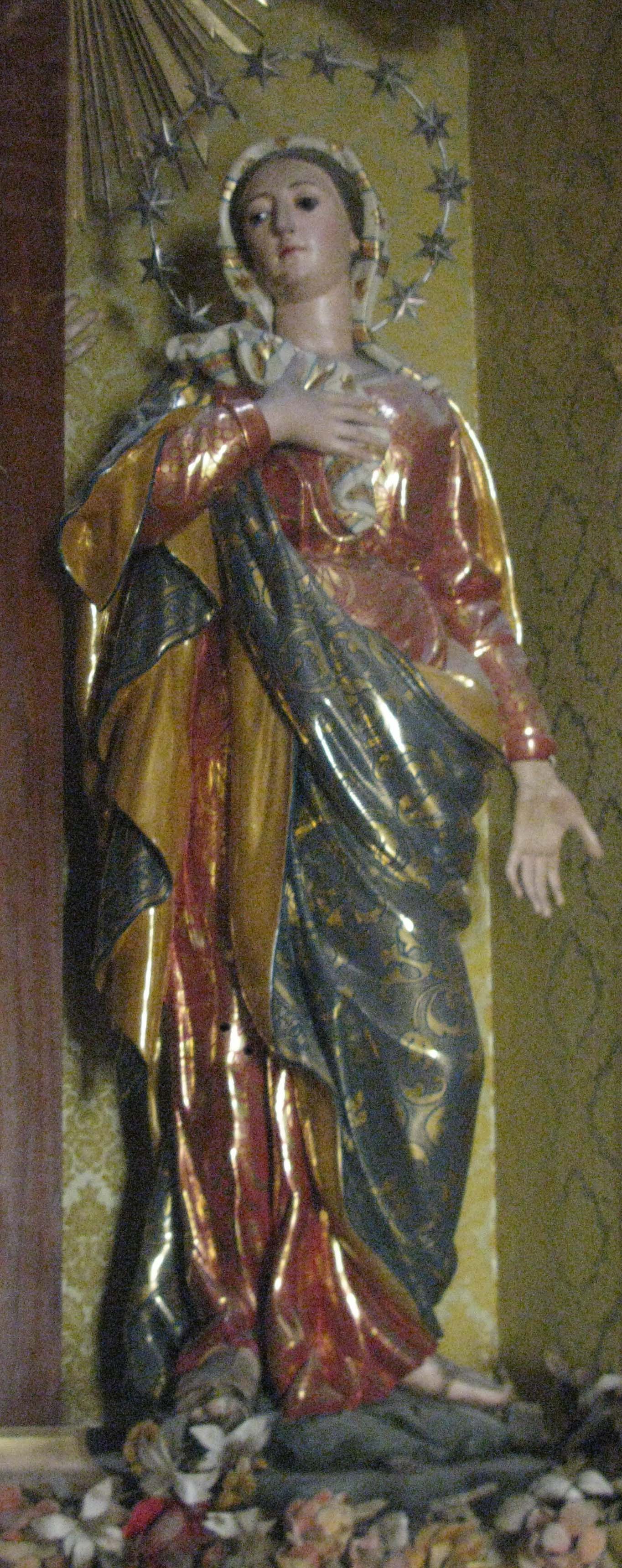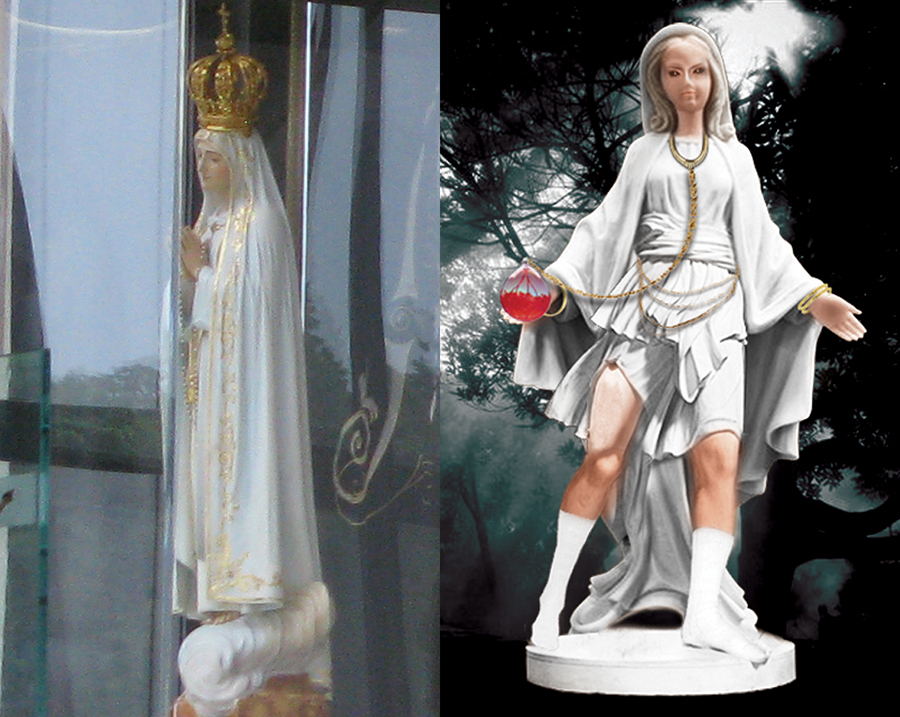Weeping Marian statues: Divine miracle or lying wonder?

Lately, I did some additional research related to the ‘miraculous signs’ many have claimed are associated with statues that various ones believe represent Jesus’ mother Mary.
There are many statues that are supposed to represent Jesus’ mother Mary. Many are bowed down before, and sometimes there are reports that some of the statues shed tears or have other signs and wonders associated with them.
Many, within Roman Catholicism as well as some without, consider these signs to be miraculous proof that Mary is present and approves these statues.
But that is not something that comes from the Bible. Instead, this type of thing comes from paganism.
Notice the following report:
It was in this very character that the Etrurian Tages was known; for it was he who was said to have taught the Romans augury, and all the superstition and wonder-working jugglery connected therewith. As in recent times, we hear of weeping images and winking Madonnas, and innumerable prodigies besides, continually occurring in the Romish Church, in proof of this papal dogma or that, so was it also in the system of Babylon. There is hardly a form of “pious fraud” or saintly imposture practised at this day on the banks of the Tiber, that cannot be proved to have had its counterpart on the banks of the Euphrates, or in the systems that came from it. Has the image of the Virgin been seen to shed tears? Many a tear was shed by the Pagan images. To these tender-hearted idols Lucan alludes, when, speaking of the prodigies that occurred during the civil wars, he says:–
“Tears shed by gods, our country’s patrons, Virgil also refers to the same, when he says:–
And sweat from Lares, told the city’s woes.”“The weeping statues did the wars foretell, When in the consulship of Appius Claudius, and Marcus Perpenna, Publius Crassus was slain in a battle with Aristonicus, Apollo’s statue at Cumae shed tears for four days without intermission. The gods had also their merry moods, as well as their weeping fits. If Rome counts it a divine accomplishment for the sacred image of her Madonna to “wink,” it was surely not less becoming in the sacred images of Paganism to relax their features into an occasional grin. That they did so, we have abundant testimony. Psellus tells us that, when the priests put forth their magic powers, “then statues laughed, and lamps were spontaneously enkindled.” When the images made merry, however, they seemed to have inspired other feelings than those of merriment into the breasts of those who beheld them. “The Theurgists,” says Salverte, “caused the appearance of the gods in the air, in the midst of gaseous vapour, disengaged from fire. The Theurgis Maximus undoubtedly made use of a secret analogous to this, when, in the fumes of the incense which he burned before the statue of Hecate, the image was seen to laugh so naturally as to fill the spectators with terror.” There were times, however, when different feelings were inspired. Has the image of the Madonna been made to look benignantly upon a favoured worshipper, and send him home assured that his prayer was heard? So did the statues of the Egyptian Isis. (Hislop A. Two Babylons. 1858. Loizeaux Brothers, Second American edition 1959, p. 257-258)
And holy sweat from brazen idols fell.”
The weeping statues of old were not Divine miracles.
Furthermore, Catholics and others should consider that the statues that allegedly are representations of the apparition that appeared in Fatima in 1917 do not possibly look like what actually appeared there. Notice the following:

Statue at Fatima Chapel and Image of That the Children Saw
Yet, there are reports of these statues weeping, bleeding, etc. Here is some of what I wrote about it in my book Fatima Shock!:
It has been reported that there are weeping and bleeding statues of the Lady of Fatima. Many people, including some of the Catholic clergy, have indicated that these types of occurrences are proof that the apparitions are Mary sent by God to the earth.
Now here is another shock–since I have no reason to doubt all the reports of weeping and/or bleeding Fatima statues, and since none of the statues that reportedly have wept look like the apparition that was originally described as appearing to the three children in Fatima in 1917, there is no way that the weeping and/or bleeding is proof that they are from God. That would be confusion.
According to the Holy Bible, “God is not the author of confusion” (1 Corinthians 14:33, NKJV) or “God is a God not of disorder” (NJB), but the devil is a liar, and the father thereof” (John 8:44, DRB).
Therefore, weeping and/or bleeding statues are further proof that the apparition seen at Fatima was not Mary sent by the God of the Bible, but instead suggest a demonic origin:
“Let them be all confounded that adore graven things” (Psalm 96:7, DRB; Psalm 97:7 is where the equivalent reference is in NJB/NKJV).
This includes statues and images that are supposed to be of Mary. And of course, the ‘Pilgrim Statues’ in Fatima do not resemble what was seen there. (Thiel B. Fatima Shock. Nazarene Books, 2012, pp. 246-247)
Those who rely on enchantments like weeping/bleeding statues are relying on something that is condemned by the Bible.
The Bible warns of a “virgin” that uses enchantments who is also called the Lady of Kingdoms. Notice the following as shown in a Catholic version of the Bible:
1 Come down, sit in the dust, O virgin daughter of Babylon, sit on the ground: there is no throne for the daughter of the Chaldeans, for thou shalt no more be called delicate and tender…4 Our redeemer, the Lord of hosts is his name, the Holy One of Israel. 5 Sit thou silent, and get thee into darkness, O daughter of the Chaldeans: for thou shalt no more be called the lady of kingdoms. 6 I was angry with my people, I have polluted my inheritance, and have given them into thy bend: thou hast shown no mercy to them: upon the ancient thou hast laid thy yoke exceeding heavy.
7 And thou hast said: I shall be a lady forever: thou hast not laid these things to thy heart, neither hast thou remembered thy latter end.
8 And now hear these things, thou that art delicate, and dwellest confidently, that sayest in thy heart: I am, and there is none else besides me: I shall not sit as a widow, and I shall not know barrenness.
9 These two things shall come upon thee suddenly in one day, barrenness and widowhood. All things are come upon thee, because of the multitude of thy sorceries, and for the great hardness of thy enchanters. 10 And thou best trusted in thy wickedness, and hast said: There is none that seeth me. Thy wisdom, and thy knowledge, this hath deceived thee. And thou best said in thy heart: I am, and besides me there is no other. 11 Evil shall come upon thee, and then shalt not know the rising thereof: and calamity shall fall violently upon thee, which thou canst not keep off: misery shall come upon thee suddenly, which thou shalt not know. 12 Stand now with thy enchanters, and with the multitude of thy sorceries, in which thou hast laboured from thy youth, if so be it may profit thee any thing, or if thou mayst become stronger. 13 Thou hast failed in the multitude or thy counsels: let now the astrologers stand and save thee, they that gazed at the stars, and counted the months, that from them they might tell the things that shall come to thee. (Isaiah 47:1, 4-7, 11-13, DRB)
Jesus warned that signs and wonders would deceive almost everybody (Matthew 24:24). Notice what the Apostle Paul warned:
9 The coming of the lawless one is according to the working of Satan, with all power, signs, and lying wonders, 10 and with all unrighteous deception among those who perish, because they did not receive the love of the truth, that they might be saved. 11 And for this reason God will send them strong delusion, that they should believe the lie, 12 that they all may be condemned who did not believe the truth but had pleasure in unrighteousness. (2 Thessalonians 2:9-12)
Deception must be clever to work, and multitudes have already been deceived by signs and wonders coming from statues–even prior to the time that the New Testament was written.
As far as the Bible goes, all should realize that there is nothing in the Bible, or even in early church writings, that supports the view that God wanted to use weeping statues, etc. of Mary. Sadly, however, multiple millions are not willing to do so.
For more information, please check out the following:
Mary, the Mother of Jesus and the Apparitions Do you know much about Mary? Are the apparitions real? What might they mean for the rise of the ecumenical religion of Antichrist? Are Protestants moving towards Mary? How do the Orthodox view Mary? How might Mary view her adorers?
Origin of the Marian Dogmas: Where Do Catholic Scholars Say The Four Dogmas of Mary Came From?
Assumption of Mary Did Mary die? Was she taken to heaven on August 15th? What is known? What does the Bible show?
Women and the New Testament Church Were women important in the New Testament Church? Which women and how were they involved?
Which Is Faithful: The Roman Catholic Church or the Genuine Church of God? Do you know that both groups shared a lot of the earliest teachings? Do you know which church changed? Do you know which group is most faithful to the teachings of the apostolic church? Which group best represents true Christianity? This documented article answers those questions. Português: Qual é fiel: A igreja católica romana ou a verdadeira igreja do deus? Tambien Español: ¿Que es fiel: La Iglesia Católica Romana o la Iglesia verdadera de Dios? Auch: Deutsch: Welches ist treu: Die römisch-katholische Kirche oder die Kirche Gottes Original?
Fatima Shock! What the Vatican Does Not Want You to Know About Fatima, Dogmas of Mary, and Future Apparitions. Whether or not you believe anything happened at Fatima, if you live long enough, you will be affected by its ramifications (cf. Isaiah 47; Revelation 17). Fatima Shock! provides concerned Christians with enough Catholic-documented facts to effectively counter every false Marian argument. In addition to the print version, there is a Kindle version of Fatima Shock! which you can acquire in seconds.
 |
Tweet |
|